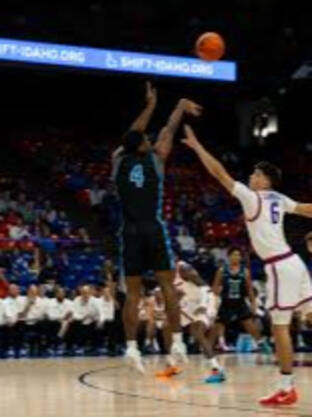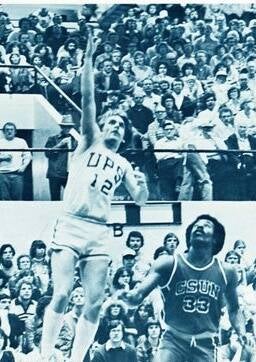Delve into the rich tapestry of college basketball history with renowned author and historian Darcy G. Richardson
Written for the college hoops junkie in all of us.
Coming in March!
Reaching for Glory
The Nation's Small Colleges Challenge the Major Powers for Hardwood Supremacy
Hawaii Pacific's Joshua West, a 6-3 senior guard from Chicago, launches a long range jumper as the Sharks stunned the Mountain West's Boise State 79-78 at the outset of the 2025-26 college basketball season. West scored a game-high 23 points on nine-of-16 shooting, including draining three-of-six shots from beyond the arc, in upsetting the heavily-favored Broncos.
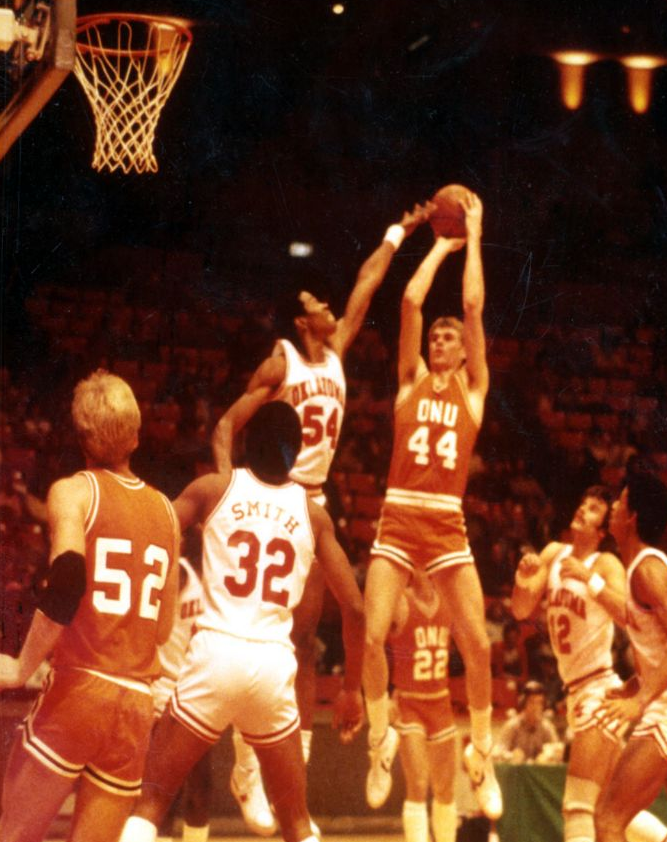
Ohio Northern University's Stan Mories launches a leaping jumper against a taller Oklahoma defender as the non-scholarship NCAA Division III Polar Bears stunned the Billy Tubbs-coached Sooners in Norman, Oklahoma, during the 1980-81 season.
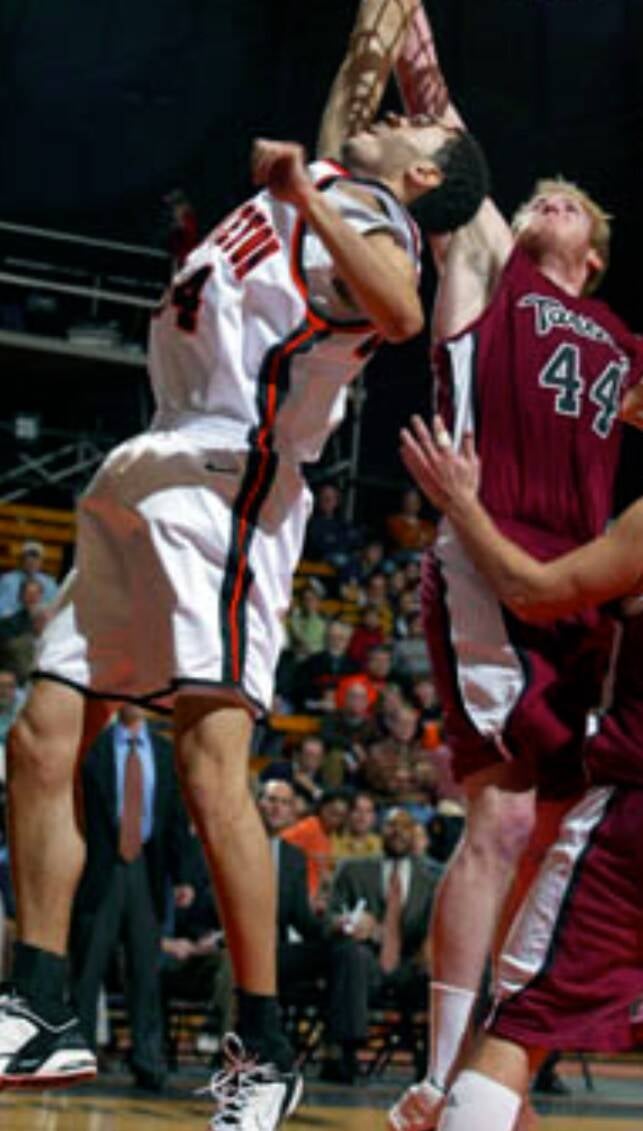
Carnegie Mellon's Nate Maurer battles under the boards as the undefeated Tartans shocked Ivy League contender Princeton 51-46 at Jadwin Gymnasium during the 2005-06 season. Maurer, a 6-7 power forward who came off the bench to score 13 points and grab eight rebounds, put Tony Wingen's squad up for good with a crucial basket with 1:21 remaining. It was Princeton's first loss ever to an NCAA Division III opponent.

Cody Baumstarck, a 6-8 junior forward from Wyoming, battles two Montana defenders as the Orediggers of Montana Tech, a longtime also-ran in the NAIA's Frontier Conference, stunned the two-time defending Big Sky Conference champion and preseason favorite 74-72 in Missoula at the outset of the 2019-20 season. Considered a regular season game for the Griz, it was Tech's first win against Montana since the late forties.
Against All Odds
Every college basketball junkie in the country is probably familiar with the “biggest upset in college basketball history,” the December night in 1982 when Honolulu’s little-known Chaminade University, a member of the time-honored NAIA with an enrollment of fewer than 900 students, pulled off one of the most highly-improbable upsets imaginable by knocking off the seemingly invincible Ralph Sampson-led Virginia Cavaliers --- the nation’s top-ranked team ---- by a score of 77-72, sending shockwaves throughout the college basketball world.
The result was utterly stunning. Most college basketball fans had never heard of Chaminade, which had upset cross-town rival Hawaii only five days earlier, handing the Rainbows their first loss to a small college since the 1978-79 season. Many couldn’t believe that undefeated Virginia (8-0), which had already drubbed the Duke Blue Devils by 13 points in Durham and toppled Patrick Ewing and the third-ranked Georgetown Hoyas 68-63 on the road three days later, had even bothered to schedule such a meaningless “stopover” contest against a small Hawaiian school.
The Terry Holland-coached Cavaliers had traveled to Japan for a couple of early season games that year, humbling 14th-ranked Houston, led by Hakeem Olajuwon and Clyde Drexler, and annihilating the WAC’s Utah Utes by 23 points three nights later.
While most fans and sportswriters reacted in startled disbelief when they heard the Christmas Eve news that a little-known small college in Hawaii had knocked off the nation’s top team, it was a refreshing reminder that there was a time in college athletics when it was almost commonplace for a smaller college --- an NAIA member, NCAA Div. II or Div. III squad, an NCCAA (National Christian College Athletic Association) institution or one of the 72-member USCAA (United States Collegiate Athletic Association) schools to play a major power on the hardwood while occasionally pulling a Chaminade-style upset.
It happened more often than one might think, including at least once in the Big Dance when little Lebanon Valley College, a tiny private college located in southern central Pennsylvania with an enrollment of barely 450 students and a diminutive men’s basketball team --- the undermanned “Iron Midgets,” whose tallest player was a mere six-foot-one --- surprised everyone by advancing to the coveted Sweet Sixteen after stunning heavily-favored Fordham at the fabled Philadelphia Palestra in the opening round of the 1953 NCAA Tournament.
It wasn't altogether uncommon for a smaller school to appear in the NCAA Tournament or the National Invitation Tournament in those days.
In addition to Lebanon Valley College, other small colleges that appeared in the Big Dance include Springfield College (1940), Catholic University (1944), Tufts University (1945), Williams College (1955), Wayne State University (1956) and the Larry Jeffries-led Trinity University Tigers (1969).
The "Peach Fuzz Five," as Trinity's players were dubbed, played a predominantly small college schedule that season while beginning its short-lived transition to the major college ranks. In fact, the Tigers were ranked No. 5 in the country in the College Division poll when they unexpectedly received a bid to the Big Dance in late February of 1969. Trinity (19-5), located in San Antonio, Texas, had advanced to the Final Four of the College Division NCAA Tournament the previous March before losing to national runner-up Indiana State, 77-67, in the semifinals.
Arguably the more prominent and profitable of the two tourneys well into the mid-fifties, the National Invitation Tournament would occasionally reserve one of its bids for a deserving smaller school, as was the case with Washington & Jefferson in 1943 and Muhlenberg University in 1946, both of which advanced to the semifinals.
In 1951, the NIT's selection committee famously invited two small colleges to play in its 12-team tournament --- Dolph Stanley's blurry-quick Beloit Buccaneers and twice-beaten Lawrence Tech, a well-coached team that came within four points of a perfect regular season.
Incredibly, the NAIA's Oklahoma City Chiefs (now called the Stars) made eleven major college NCAA Tournament appearances and twice played in the NIT between 1952 and 1973 under the guiding influence of the legendary Abe Lemons and his capable predecessor Doyle Parrack.
Postseason tournaments aside, small colleges across the country --- and occasionally beyond --- frequently upset their major college opponents in those days and have continued to do so in the years following the NCAA's decision to segregate its member institutions into the so-called "University Division" (major college) and "College Division" (small college) ranks in 1957 and again later when the NCAA's governing body further bureaucratized collegiate athletics by creating three separate divisions in 1973, each with its own postseason NCAA Tournament.
Until the late 1950s, every school in the country, regardless of the size of its enrollment or the constraints of its athletic budget, had a fighting chance on the hardwood.
Though given far fewer opportunities to play Division I schools today than in the past --- and, sadly, many of those games are designated as "exhibition" contests --- small colleges continue to occasionally defeat their major college opponents, as was the case during the recent 2024-25 college basketball season when the NAIA's University of North Texas-Dallas upset Rice University 69-68 and Division II Michigan Tech --- "Nobody U." --- famously knocked off Doug Gottlieb's struggling UW Green Bay Phoenix 72-70.
Similar upsets have occurred in virtually every season since the late 1950s, often on multiple occasions in the same season. Hundreds of those games are featured in Darcy Richardson's latest book.
In the late 1950s and throughout the 1960s, shortly after the NCAA divided the nation's schools into the "University" and "College" divisions by placing 156 schools in the major college ranks and 285 in the small college category, there were upsets galore, many of them involving traditional rivalries between schools which suddenly found themselves playing in two different divisions.
During the 1956-57 season --- the first season in which the nation's schools had been separated into major college and minor college categories --- dozens of small colleges knocked off University Division teams.

One of two Division II teams to knock off a Big Ten team in preseason action that year, Grand Valley State surprised the college basketball world by upsetting eighth-ranked Michigan State 85-82 in double overtime in an exhibition game at the outset of the 2007-08 campaign. A member of the Great Lakes Intercollegiate Athletic Conference, the Lakers won 36 straight games that season before losing to Winona State in the Division II NCAA Tournament quarterfinals. Led by longtime mentor Ron Niekamp, the University of Findlay also turned some heads later that same week by shocking Ohio State 70-68 in Columbus, Ohio.
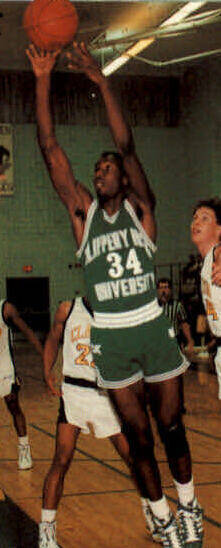
Sensational 6-3 shooting guard Myron Brown, a second round NBA draft pick by the Minnesota Timberwolves in 1991, led Division II Slippery Rock University (Pa.) to upset victories over major college opponemts Navy, Cleveland State, the University of Central Florida and Youngstown State during his freshman, sophomore and junior years. The Rock also nearly defeated Western Michigan, Robert Morris University and St. Francis of Loretto during Brown's collegiate career.
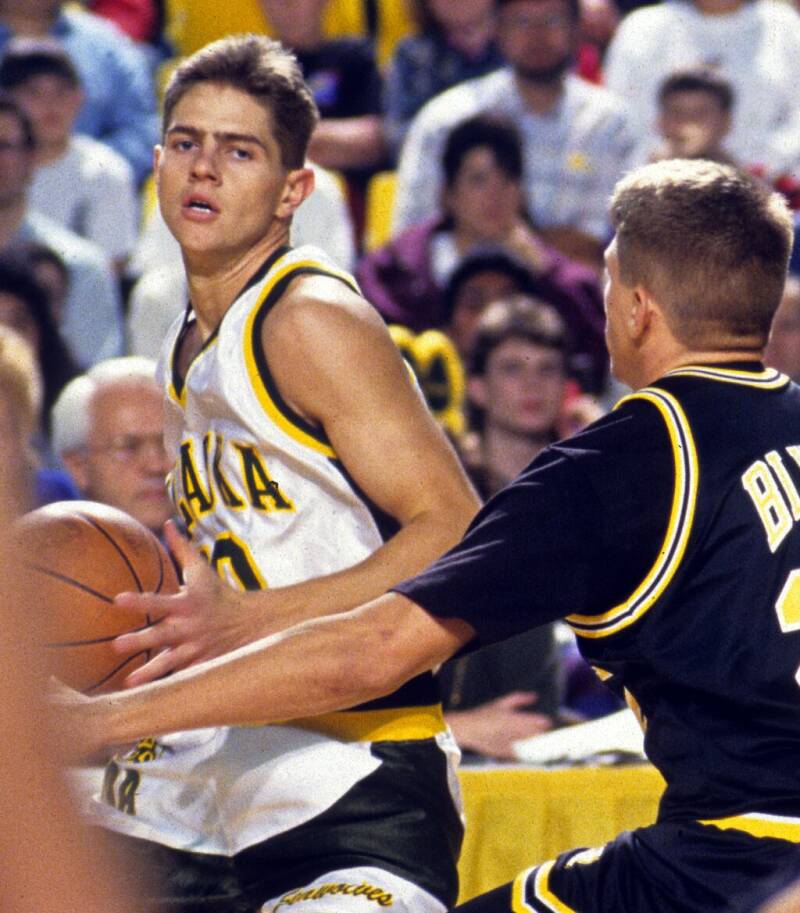
John Kaiser's brilliant game-high 35-point performance lifted the University of Alaska-Anchorage, a Division II program, to a stunning 70-68 victory over perennial ACC power Wake Forest in the 1993 Great Alaska Shootout. Kaiser, a 6-5 Weber State transfer and native of Anchorage, connected on a brisk 12 of 21 shots from the floor, including five 3-pointers, to give the host Seawolves one of their biggest wins in program history.
The Lethal Loggers
The University of Puget Sound won no fewer than a half-dozen games against major college opponents during the 1969-70 season, defeating Gonzaga, Fresno State, Montana, Hardin-Simmons and the University of Portland, beating the Pilots twice that year. The same thing was true the following season when the Loggers, boasting one of the best backcourts in the nation in Ed Huston and Charles Lowery, outgunned Gonzaga 111-88 while also routing St. Mary’s (Ca.) 96-76. Winning 23 of 28 games before losing an 81-80 heartbreaker in overtime to national runner-up Old Dominion in the NCAA College Division quarterfinals, Puget Sound also defeated Idaho, Portland and Seattle and toppled the Big Sky's Montana Grizzlies twice in home-and-away games that season.
Upset Special Blog
Little Chico State Stuns Undefeated Stanford in 1982
June 7, 2025
Tim Taylor canned a 20-foot jumper from the top of the key with four seconds remaining and Homer Rivers calmly sank a pair of free throws with two seconds left to lift little Chico State past undefeated Stanford 82-78 in 1982, giving the Division II visitors from Chico one of the biggest victories in school history while handing first-year coach Tom Davis his first loss at Stanford.
Coming off a huge win against St. Mary's (Ca), Stanford had won its first five games that season while Chico State had dropped four of its first five contests. All four losses were on the road against Division I opponents.
"Chico played very well," acknowledged Davis, who had guided Lafayette and Boston College to eleven consecutive winning seasons before taking over the reins at the Pac-10 school. "It may have been a letdown following our victory over St. Mary's, but our opponent had a lot to do with that, forcing us to make errors that we do not ordinarily make."
Chico stole the ball thirteen times and forced the heavily-favored Cardinal into an uncharacteristic 24 turnovers.
Chico State's guard tandem of Taylor and Rivers paced the upset-minded Wildcats with 24 and 22 points, respectively. Taylor, who set a single-game school record for field goals that season by making 18 of 23 shots from the floor in a 75-69 loss to Toledo, made 13 of 18 field goal attempts against Stanford while Rivers, the team's leading scorer that year, buried 9 of 14 shots from the floor and dished off a game-high seven assists.
It was an astonishing upset, especially given the fact that Chico State only took a paltry eleven shots from the charity stripe compared to Stanford's 32 free throw attempts.
Previously Published & Forthcoming Books
Pviously Published Forthom
A Nation Divided: The 1968 Presidential Campaign (2002)
Others I: Third-Party Politics from the Nation’s Founding to the Rise & Fall of the Greenback-Labor Party (2004)
Others II: Third Parties during the Populist Period (2007)
Others III: Third Parties from Teddy Roosevelt’s Bull Moose Party to the Decline of Socialism in America (2007)
Others IV: “Fighting Bob” La Follette and the Progressive Movement — Third-Party Politics in the 1920s (2008)
The Left-Hitting Gravedigger (2012)
A Toast to Glory: The Prohibition Party Flirts With Greatness (2012)
Comebacks and Second Acts in American Politics (2012)
Bernie: A Lifelong Crusade Against Wall Street & Wealth (2015)
Loyola's Improbable Ramblers: 55 Years in the Making (2019)
The Lowest Ebb: Norman Thomas & America’s Minor Parties in 1944 (2020)
Battling Bob: Fighting the Financial Oligarchy (2025)
McGovern: The Last Hurrah (2025)
Reaching for Glory: The Nation's Small Colleges Challenge the Major Powers for Hardwood Supremacy (2025)
The Fearless FCS: A History of College Football's Division I-AA and the Football Championship Subdivision
The Wondrous Warriors: Lewis-Clark State and the Making of College Baseball's Greatest Dynasty
Battling the Duopoly: A Short History of the Reform Party's Struggle to Save America's Middle Class
Others V: Third Parties during the Great Depression
A Puritanical Presidency: Economist Roger Babson Campaigns for the White House
The Spirit of ’76: Eugene McCarthy’s Lonely Quest for Open Politics
Prejudice and Pride: The Remarkable Story of the 1951 University of San Francisco Football Team
Working-Class Champions: A History of the Socialist Labor Party
Others VI: Third-Party Movements from Henry A. Wallace to George C. Wallace
Airbrushed from History: Henry Carey and the American System of Political Economy
Boy Wonder: Harold Stassen’s Lifelong Pursuit of the Elusive Brass Ring
The Rock: A Short History of America's Most Fabled Small College Football Program
Others VII: The Duopoly Survives the Perot Phenomenon

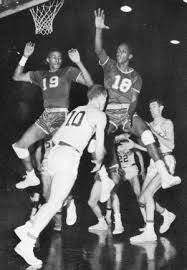
Flashback
A decade before the Don Haskins-led UTEP Miners and their all-black starting lineup defeated Kentucky for the national championship, Detroit's racially-diverse Wayne State University, an inner-city school which played a non-major college schedule that season, fiercely battled heavily-favored Kentucky in the second round of the 1956 NCAA Tournament.
Riding a 17-game winning streak and fresh from a sophomore guard Clarence Straughn-led first round victory over DePaul, the upset-minded Warriors (18-3) led by two points at halftime before falling to Adolph Rupp's Wildcats, 84-64. A poorly officiated game by some accounts --- while trailing by only four points, Wayne State's best player, 6-6 center George Brown was whistled for his fifth foul early in the second half by the all-white officiating crew --- the Wayne State-Kentucky clash marked the last time a small college team appeared in the Big Dance
About
The chronicler of a multivolume series on independent and third-party politics in the United States, award-winning historian Darcy G. Richardson has written more than a dozen books on American politics and history. The recipient of an Outstanding Academic Title (OAT) from the American Library Association and prestigious Choice magazine in 2005, Richardson's books were featured in Newsweek's "What You Need to Read Now" section in July 2010.
A former sportswriter for The Fanatic, Darcy is also the author of The Left-Hitting Gravedigger (JMW Publishing, 2012) and Loyola's Improbable Ramblers: 55 Years in the Making (Sevierville Publishing, 2019).
Darcy can be reached at darcyrichardson@comcast.net.
